Organisational Behaviour Report: David & Co. Ltd Analysis
VerifiedAdded on 2020/12/09
|14
|4940
|364
Report
AI Summary
This report provides an in-depth analysis of organisational behaviour within A David and Company Ltd, a food and beverage wholesaler. The report begins with an introduction to organisational behaviour, defining its role in creating efficient workplaces and examining human behaviour within organisations. Task 1 analyzes the influence of culture, politics, and power on employee behaviour, exploring power dynamics through French and Raven's power types and Chanlat's characteristics of political behaviour, as well as Handy's cultural typology model. Task 2 delves into motivational theories, focusing on content theories and Maslow's hierarchy of needs. The report also examines the impact of organizational culture, politics, and power on group and individual behaviour. The analysis includes the influence of culture, politics, and power on the behaviour of employees, along with the role of motivation theory in the achievement of organizational goals, team effectiveness, and various concepts and philosophies of OB. The conclusion summarizes the key findings and recommendations based on the analysis.
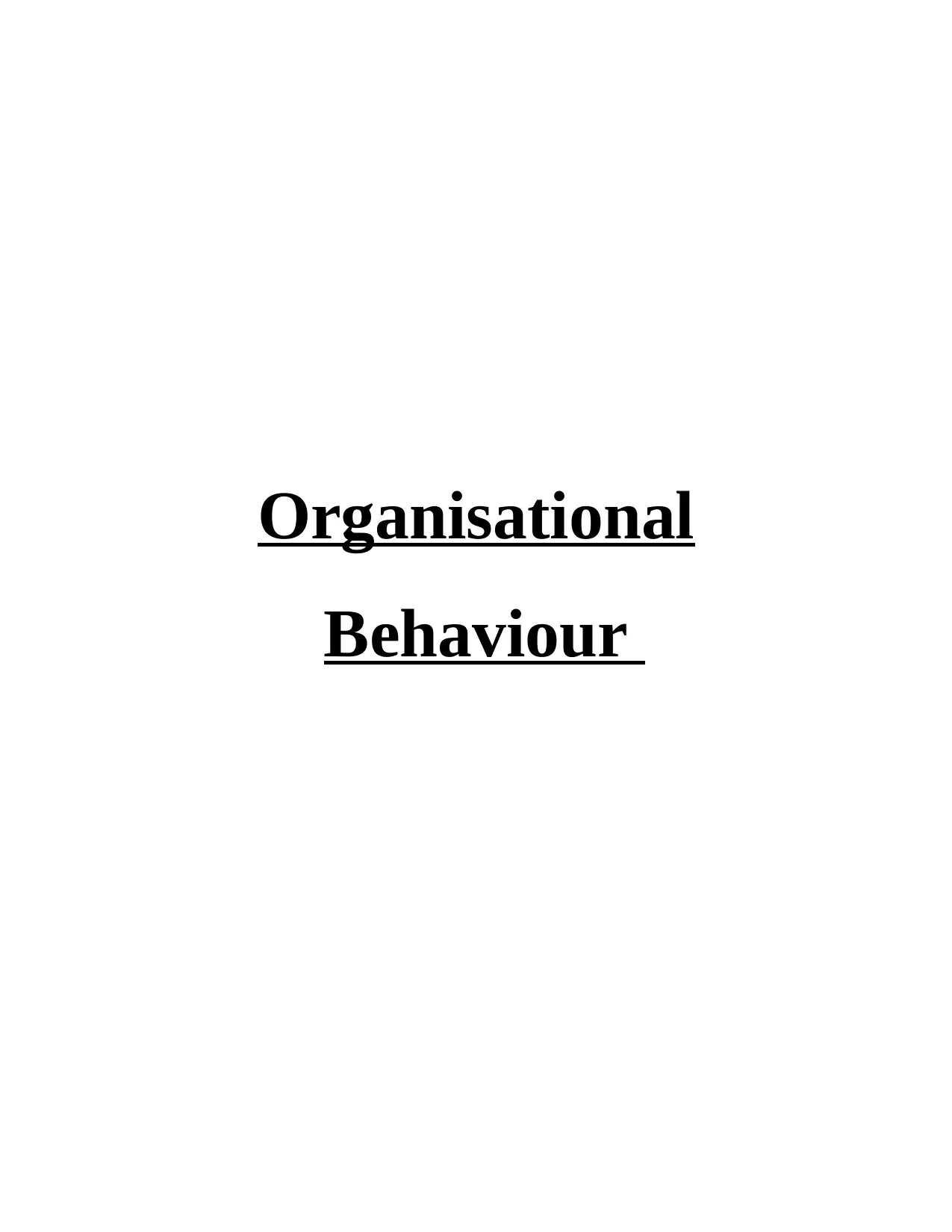
Organisational
Behaviour
Behaviour
Paraphrase This Document
Need a fresh take? Get an instant paraphrase of this document with our AI Paraphraser
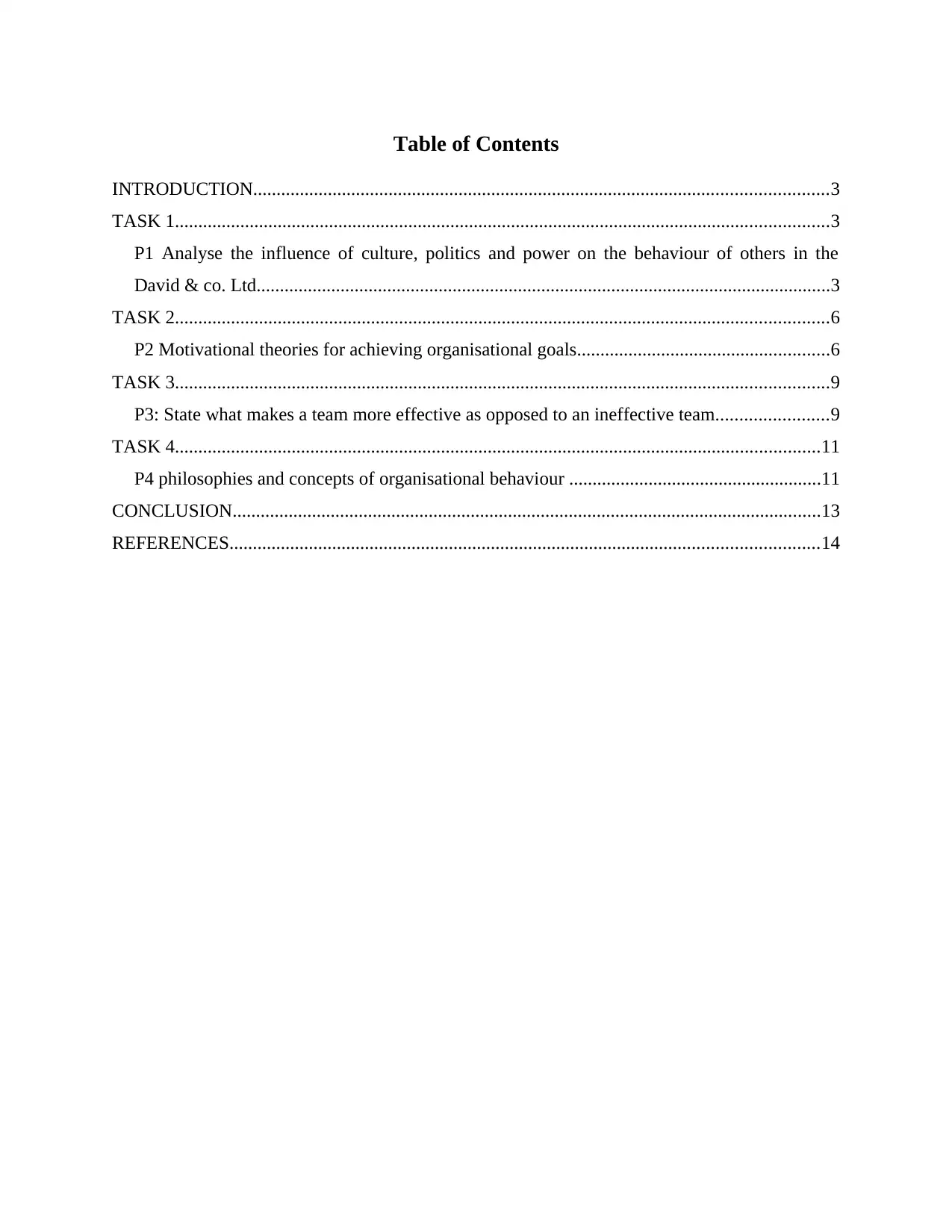
Table of Contents
INTRODUCTION...........................................................................................................................3
TASK 1............................................................................................................................................3
P1 Analyse the influence of culture, politics and power on the behaviour of others in the
David & co. Ltd...........................................................................................................................3
TASK 2............................................................................................................................................6
P2 Motivational theories for achieving organisational goals......................................................6
TASK 3............................................................................................................................................9
P3: State what makes a team more effective as opposed to an ineffective team........................9
TASK 4..........................................................................................................................................11
P4 philosophies and concepts of organisational behaviour ......................................................11
CONCLUSION..............................................................................................................................13
REFERENCES..............................................................................................................................14
INTRODUCTION...........................................................................................................................3
TASK 1............................................................................................................................................3
P1 Analyse the influence of culture, politics and power on the behaviour of others in the
David & co. Ltd...........................................................................................................................3
TASK 2............................................................................................................................................6
P2 Motivational theories for achieving organisational goals......................................................6
TASK 3............................................................................................................................................9
P3: State what makes a team more effective as opposed to an ineffective team........................9
TASK 4..........................................................................................................................................11
P4 philosophies and concepts of organisational behaviour ......................................................11
CONCLUSION..............................................................................................................................13
REFERENCES..............................................................................................................................14
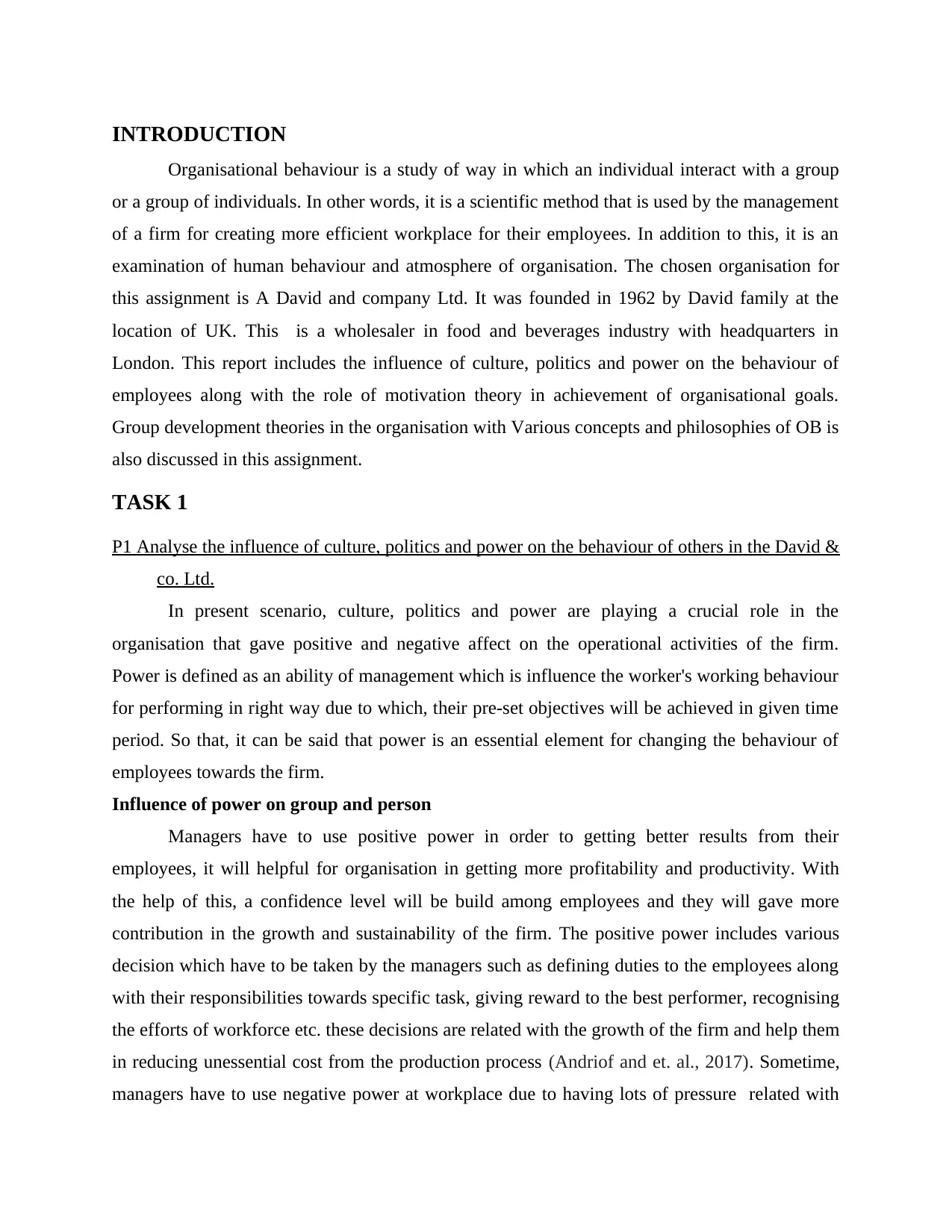
INTRODUCTION
Organisational behaviour is a study of way in which an individual interact with a group
or a group of individuals. In other words, it is a scientific method that is used by the management
of a firm for creating more efficient workplace for their employees. In addition to this, it is an
examination of human behaviour and atmosphere of organisation. The chosen organisation for
this assignment is A David and company Ltd. It was founded in 1962 by David family at the
location of UK. This is a wholesaler in food and beverages industry with headquarters in
London. This report includes the influence of culture, politics and power on the behaviour of
employees along with the role of motivation theory in achievement of organisational goals.
Group development theories in the organisation with Various concepts and philosophies of OB is
also discussed in this assignment.
TASK 1
P1 Analyse the influence of culture, politics and power on the behaviour of others in the David &
co. Ltd.
In present scenario, culture, politics and power are playing a crucial role in the
organisation that gave positive and negative affect on the operational activities of the firm.
Power is defined as an ability of management which is influence the worker's working behaviour
for performing in right way due to which, their pre-set objectives will be achieved in given time
period. So that, it can be said that power is an essential element for changing the behaviour of
employees towards the firm.
Influence of power on group and person
Managers have to use positive power in order to getting better results from their
employees, it will helpful for organisation in getting more profitability and productivity. With
the help of this, a confidence level will be build among employees and they will gave more
contribution in the growth and sustainability of the firm. The positive power includes various
decision which have to be taken by the managers such as defining duties to the employees along
with their responsibilities towards specific task, giving reward to the best performer, recognising
the efforts of workforce etc. these decisions are related with the growth of the firm and help them
in reducing unessential cost from the production process (Andriof and et. al., 2017). Sometime,
managers have to use negative power at workplace due to having lots of pressure related with
Organisational behaviour is a study of way in which an individual interact with a group
or a group of individuals. In other words, it is a scientific method that is used by the management
of a firm for creating more efficient workplace for their employees. In addition to this, it is an
examination of human behaviour and atmosphere of organisation. The chosen organisation for
this assignment is A David and company Ltd. It was founded in 1962 by David family at the
location of UK. This is a wholesaler in food and beverages industry with headquarters in
London. This report includes the influence of culture, politics and power on the behaviour of
employees along with the role of motivation theory in achievement of organisational goals.
Group development theories in the organisation with Various concepts and philosophies of OB is
also discussed in this assignment.
TASK 1
P1 Analyse the influence of culture, politics and power on the behaviour of others in the David &
co. Ltd.
In present scenario, culture, politics and power are playing a crucial role in the
organisation that gave positive and negative affect on the operational activities of the firm.
Power is defined as an ability of management which is influence the worker's working behaviour
for performing in right way due to which, their pre-set objectives will be achieved in given time
period. So that, it can be said that power is an essential element for changing the behaviour of
employees towards the firm.
Influence of power on group and person
Managers have to use positive power in order to getting better results from their
employees, it will helpful for organisation in getting more profitability and productivity. With
the help of this, a confidence level will be build among employees and they will gave more
contribution in the growth and sustainability of the firm. The positive power includes various
decision which have to be taken by the managers such as defining duties to the employees along
with their responsibilities towards specific task, giving reward to the best performer, recognising
the efforts of workforce etc. these decisions are related with the growth of the firm and help them
in reducing unessential cost from the production process (Andriof and et. al., 2017). Sometime,
managers have to use negative power at workplace due to having lots of pressure related with
⊘ This is a preview!⊘
Do you want full access?
Subscribe today to unlock all pages.

Trusted by 1+ million students worldwide
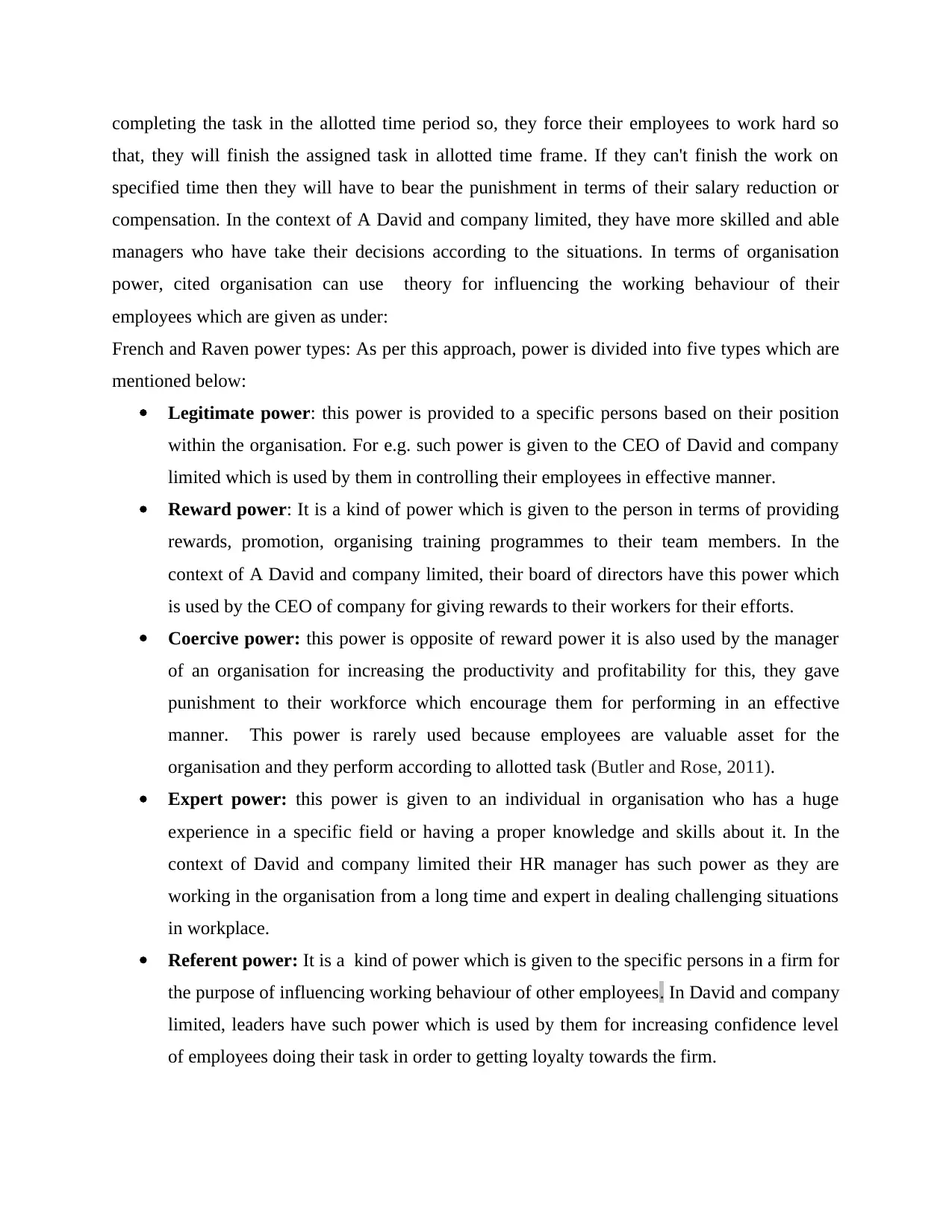
completing the task in the allotted time period so, they force their employees to work hard so
that, they will finish the assigned task in allotted time frame. If they can't finish the work on
specified time then they will have to bear the punishment in terms of their salary reduction or
compensation. In the context of A David and company limited, they have more skilled and able
managers who have take their decisions according to the situations. In terms of organisation
power, cited organisation can use theory for influencing the working behaviour of their
employees which are given as under:
French and Raven power types: As per this approach, power is divided into five types which are
mentioned below:
Legitimate power: this power is provided to a specific persons based on their position
within the organisation. For e.g. such power is given to the CEO of David and company
limited which is used by them in controlling their employees in effective manner.
Reward power: It is a kind of power which is given to the person in terms of providing
rewards, promotion, organising training programmes to their team members. In the
context of A David and company limited, their board of directors have this power which
is used by the CEO of company for giving rewards to their workers for their efforts.
Coercive power: this power is opposite of reward power it is also used by the manager
of an organisation for increasing the productivity and profitability for this, they gave
punishment to their workforce which encourage them for performing in an effective
manner. This power is rarely used because employees are valuable asset for the
organisation and they perform according to allotted task (Butler and Rose, 2011).
Expert power: this power is given to an individual in organisation who has a huge
experience in a specific field or having a proper knowledge and skills about it. In the
context of David and company limited their HR manager has such power as they are
working in the organisation from a long time and expert in dealing challenging situations
in workplace.
Referent power: It is a kind of power which is given to the specific persons in a firm for
the purpose of influencing working behaviour of other employees. In David and company
limited, leaders have such power which is used by them for increasing confidence level
of employees doing their task in order to getting loyalty towards the firm.
that, they will finish the assigned task in allotted time frame. If they can't finish the work on
specified time then they will have to bear the punishment in terms of their salary reduction or
compensation. In the context of A David and company limited, they have more skilled and able
managers who have take their decisions according to the situations. In terms of organisation
power, cited organisation can use theory for influencing the working behaviour of their
employees which are given as under:
French and Raven power types: As per this approach, power is divided into five types which are
mentioned below:
Legitimate power: this power is provided to a specific persons based on their position
within the organisation. For e.g. such power is given to the CEO of David and company
limited which is used by them in controlling their employees in effective manner.
Reward power: It is a kind of power which is given to the person in terms of providing
rewards, promotion, organising training programmes to their team members. In the
context of A David and company limited, their board of directors have this power which
is used by the CEO of company for giving rewards to their workers for their efforts.
Coercive power: this power is opposite of reward power it is also used by the manager
of an organisation for increasing the productivity and profitability for this, they gave
punishment to their workforce which encourage them for performing in an effective
manner. This power is rarely used because employees are valuable asset for the
organisation and they perform according to allotted task (Butler and Rose, 2011).
Expert power: this power is given to an individual in organisation who has a huge
experience in a specific field or having a proper knowledge and skills about it. In the
context of David and company limited their HR manager has such power as they are
working in the organisation from a long time and expert in dealing challenging situations
in workplace.
Referent power: It is a kind of power which is given to the specific persons in a firm for
the purpose of influencing working behaviour of other employees. In David and company
limited, leaders have such power which is used by them for increasing confidence level
of employees doing their task in order to getting loyalty towards the firm.
Paraphrase This Document
Need a fresh take? Get an instant paraphrase of this document with our AI Paraphraser
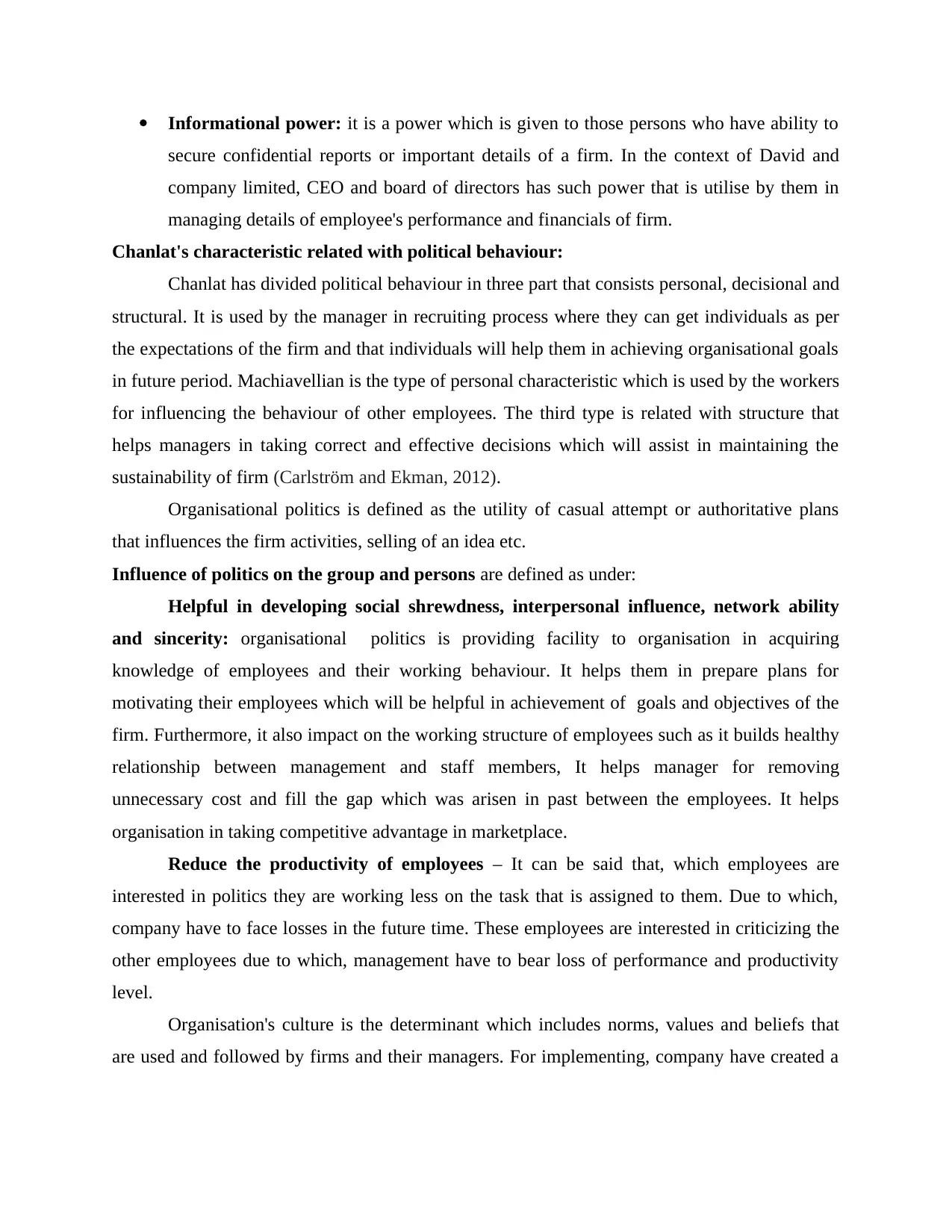
Informational power: it is a power which is given to those persons who have ability to
secure confidential reports or important details of a firm. In the context of David and
company limited, CEO and board of directors has such power that is utilise by them in
managing details of employee's performance and financials of firm.
Chanlat's characteristic related with political behaviour:
Chanlat has divided political behaviour in three part that consists personal, decisional and
structural. It is used by the manager in recruiting process where they can get individuals as per
the expectations of the firm and that individuals will help them in achieving organisational goals
in future period. Machiavellian is the type of personal characteristic which is used by the workers
for influencing the behaviour of other employees. The third type is related with structure that
helps managers in taking correct and effective decisions which will assist in maintaining the
sustainability of firm (Carlström and Ekman, 2012).
Organisational politics is defined as the utility of casual attempt or authoritative plans
that influences the firm activities, selling of an idea etc.
Influence of politics on the group and persons are defined as under:
Helpful in developing social shrewdness, interpersonal influence, network ability
and sincerity: organisational politics is providing facility to organisation in acquiring
knowledge of employees and their working behaviour. It helps them in prepare plans for
motivating their employees which will be helpful in achievement of goals and objectives of the
firm. Furthermore, it also impact on the working structure of employees such as it builds healthy
relationship between management and staff members, It helps manager for removing
unnecessary cost and fill the gap which was arisen in past between the employees. It helps
organisation in taking competitive advantage in marketplace.
Reduce the productivity of employees – It can be said that, which employees are
interested in politics they are working less on the task that is assigned to them. Due to which,
company have to face losses in the future time. These employees are interested in criticizing the
other employees due to which, management have to bear loss of performance and productivity
level.
Organisation's culture is the determinant which includes norms, values and beliefs that
are used and followed by firms and their managers. For implementing, company have created a
secure confidential reports or important details of a firm. In the context of David and
company limited, CEO and board of directors has such power that is utilise by them in
managing details of employee's performance and financials of firm.
Chanlat's characteristic related with political behaviour:
Chanlat has divided political behaviour in three part that consists personal, decisional and
structural. It is used by the manager in recruiting process where they can get individuals as per
the expectations of the firm and that individuals will help them in achieving organisational goals
in future period. Machiavellian is the type of personal characteristic which is used by the workers
for influencing the behaviour of other employees. The third type is related with structure that
helps managers in taking correct and effective decisions which will assist in maintaining the
sustainability of firm (Carlström and Ekman, 2012).
Organisational politics is defined as the utility of casual attempt or authoritative plans
that influences the firm activities, selling of an idea etc.
Influence of politics on the group and persons are defined as under:
Helpful in developing social shrewdness, interpersonal influence, network ability
and sincerity: organisational politics is providing facility to organisation in acquiring
knowledge of employees and their working behaviour. It helps them in prepare plans for
motivating their employees which will be helpful in achievement of goals and objectives of the
firm. Furthermore, it also impact on the working structure of employees such as it builds healthy
relationship between management and staff members, It helps manager for removing
unnecessary cost and fill the gap which was arisen in past between the employees. It helps
organisation in taking competitive advantage in marketplace.
Reduce the productivity of employees – It can be said that, which employees are
interested in politics they are working less on the task that is assigned to them. Due to which,
company have to face losses in the future time. These employees are interested in criticizing the
other employees due to which, management have to bear loss of performance and productivity
level.
Organisation's culture is the determinant which includes norms, values and beliefs that
are used and followed by firms and their managers. For implementing, company have created a
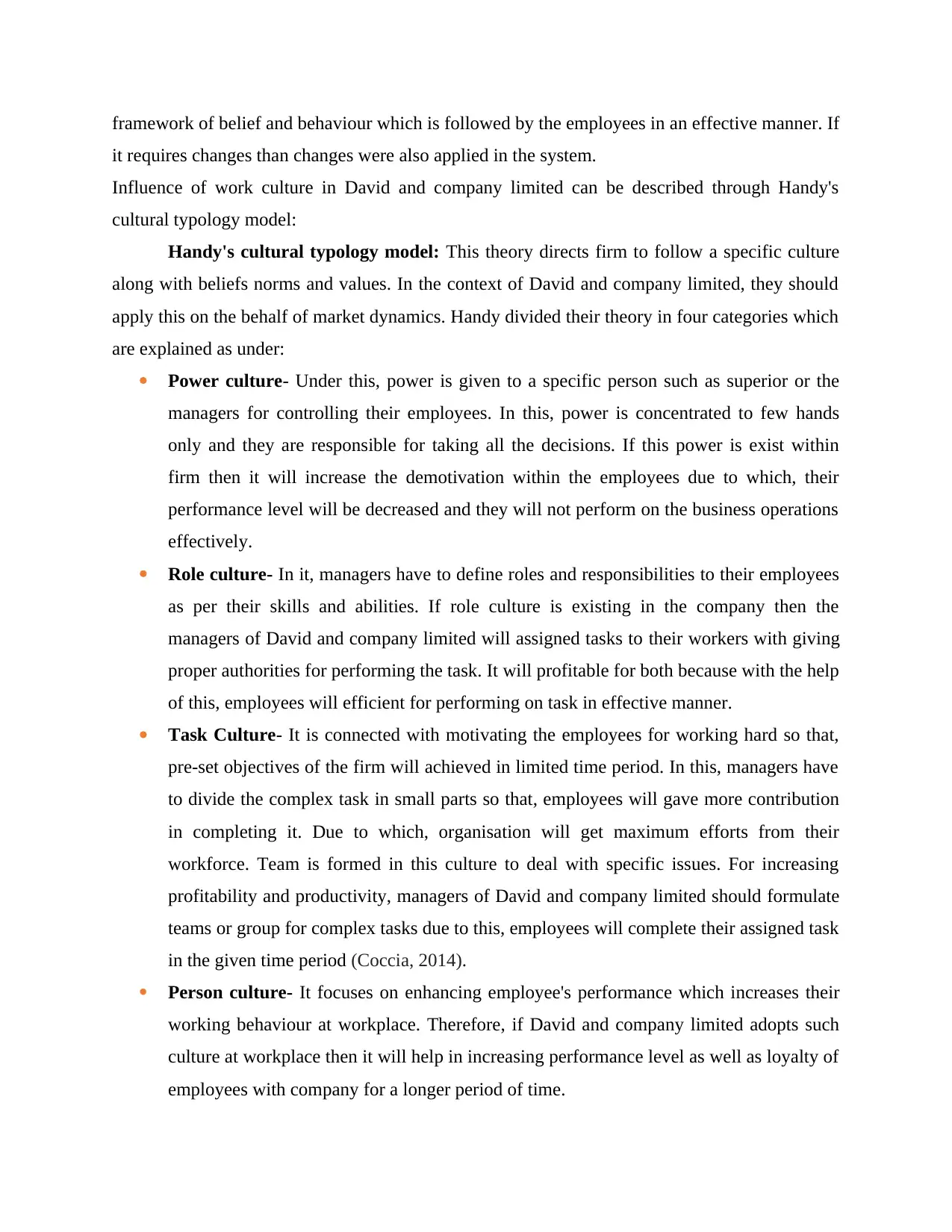
framework of belief and behaviour which is followed by the employees in an effective manner. If
it requires changes than changes were also applied in the system.
Influence of work culture in David and company limited can be described through Handy's
cultural typology model:
Handy's cultural typology model: This theory directs firm to follow a specific culture
along with beliefs norms and values. In the context of David and company limited, they should
apply this on the behalf of market dynamics. Handy divided their theory in four categories which
are explained as under:
Power culture- Under this, power is given to a specific person such as superior or the
managers for controlling their employees. In this, power is concentrated to few hands
only and they are responsible for taking all the decisions. If this power is exist within
firm then it will increase the demotivation within the employees due to which, their
performance level will be decreased and they will not perform on the business operations
effectively.
Role culture- In it, managers have to define roles and responsibilities to their employees
as per their skills and abilities. If role culture is existing in the company then the
managers of David and company limited will assigned tasks to their workers with giving
proper authorities for performing the task. It will profitable for both because with the help
of this, employees will efficient for performing on task in effective manner.
Task Culture- It is connected with motivating the employees for working hard so that,
pre-set objectives of the firm will achieved in limited time period. In this, managers have
to divide the complex task in small parts so that, employees will gave more contribution
in completing it. Due to which, organisation will get maximum efforts from their
workforce. Team is formed in this culture to deal with specific issues. For increasing
profitability and productivity, managers of David and company limited should formulate
teams or group for complex tasks due to this, employees will complete their assigned task
in the given time period (Coccia, 2014).
Person culture- It focuses on enhancing employee's performance which increases their
working behaviour at workplace. Therefore, if David and company limited adopts such
culture at workplace then it will help in increasing performance level as well as loyalty of
employees with company for a longer period of time.
it requires changes than changes were also applied in the system.
Influence of work culture in David and company limited can be described through Handy's
cultural typology model:
Handy's cultural typology model: This theory directs firm to follow a specific culture
along with beliefs norms and values. In the context of David and company limited, they should
apply this on the behalf of market dynamics. Handy divided their theory in four categories which
are explained as under:
Power culture- Under this, power is given to a specific person such as superior or the
managers for controlling their employees. In this, power is concentrated to few hands
only and they are responsible for taking all the decisions. If this power is exist within
firm then it will increase the demotivation within the employees due to which, their
performance level will be decreased and they will not perform on the business operations
effectively.
Role culture- In it, managers have to define roles and responsibilities to their employees
as per their skills and abilities. If role culture is existing in the company then the
managers of David and company limited will assigned tasks to their workers with giving
proper authorities for performing the task. It will profitable for both because with the help
of this, employees will efficient for performing on task in effective manner.
Task Culture- It is connected with motivating the employees for working hard so that,
pre-set objectives of the firm will achieved in limited time period. In this, managers have
to divide the complex task in small parts so that, employees will gave more contribution
in completing it. Due to which, organisation will get maximum efforts from their
workforce. Team is formed in this culture to deal with specific issues. For increasing
profitability and productivity, managers of David and company limited should formulate
teams or group for complex tasks due to this, employees will complete their assigned task
in the given time period (Coccia, 2014).
Person culture- It focuses on enhancing employee's performance which increases their
working behaviour at workplace. Therefore, if David and company limited adopts such
culture at workplace then it will help in increasing performance level as well as loyalty of
employees with company for a longer period of time.
⊘ This is a preview!⊘
Do you want full access?
Subscribe today to unlock all pages.

Trusted by 1+ million students worldwide
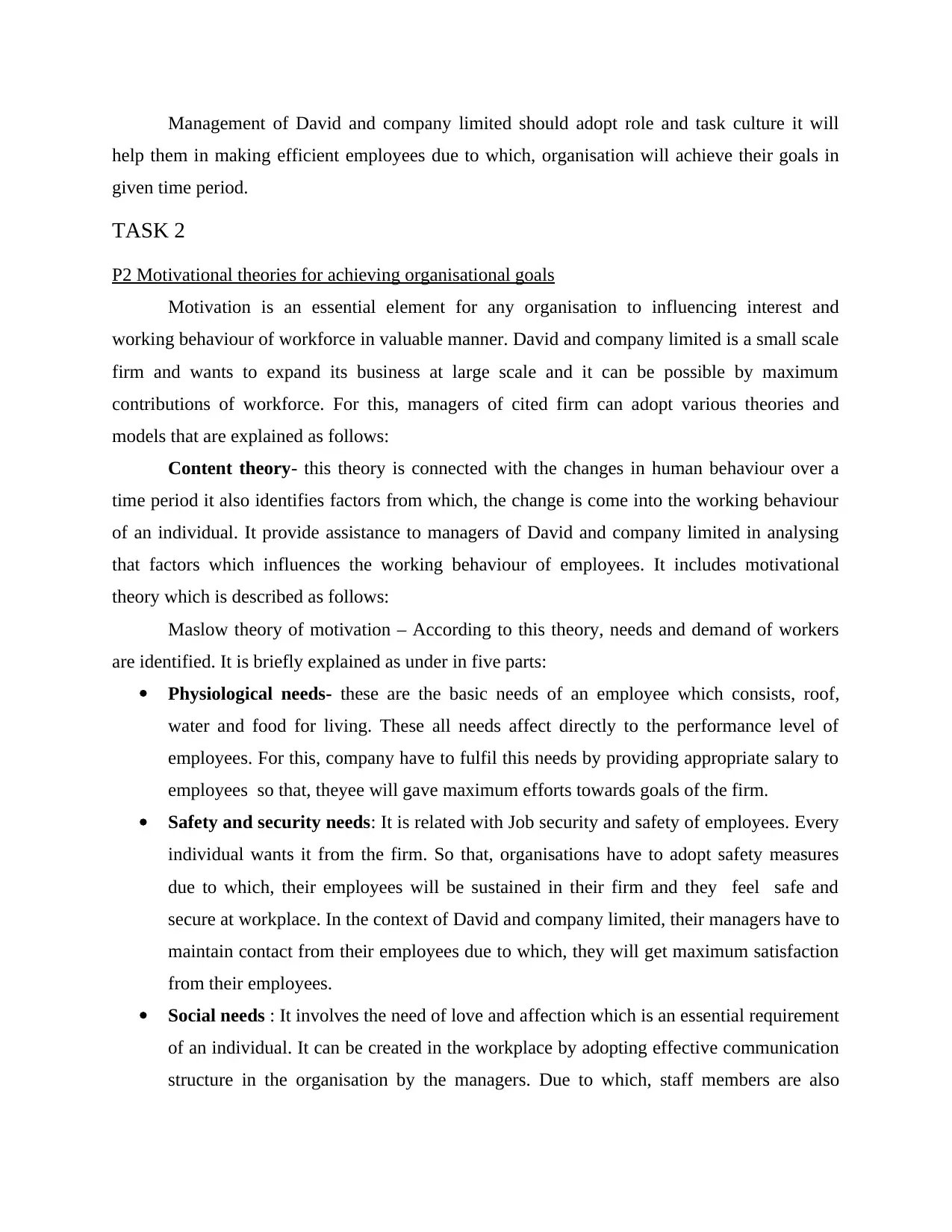
Management of David and company limited should adopt role and task culture it will
help them in making efficient employees due to which, organisation will achieve their goals in
given time period.
TASK 2
P2 Motivational theories for achieving organisational goals
Motivation is an essential element for any organisation to influencing interest and
working behaviour of workforce in valuable manner. David and company limited is a small scale
firm and wants to expand its business at large scale and it can be possible by maximum
contributions of workforce. For this, managers of cited firm can adopt various theories and
models that are explained as follows:
Content theory- this theory is connected with the changes in human behaviour over a
time period it also identifies factors from which, the change is come into the working behaviour
of an individual. It provide assistance to managers of David and company limited in analysing
that factors which influences the working behaviour of employees. It includes motivational
theory which is described as follows:
Maslow theory of motivation – According to this theory, needs and demand of workers
are identified. It is briefly explained as under in five parts:
Physiological needs- these are the basic needs of an employee which consists, roof,
water and food for living. These all needs affect directly to the performance level of
employees. For this, company have to fulfil this needs by providing appropriate salary to
employees so that, theyee will gave maximum efforts towards goals of the firm.
Safety and security needs: It is related with Job security and safety of employees. Every
individual wants it from the firm. So that, organisations have to adopt safety measures
due to which, their employees will be sustained in their firm and they feel safe and
secure at workplace. In the context of David and company limited, their managers have to
maintain contact from their employees due to which, they will get maximum satisfaction
from their employees.
Social needs : It involves the need of love and affection which is an essential requirement
of an individual. It can be created in the workplace by adopting effective communication
structure in the organisation by the managers. Due to which, staff members are also
help them in making efficient employees due to which, organisation will achieve their goals in
given time period.
TASK 2
P2 Motivational theories for achieving organisational goals
Motivation is an essential element for any organisation to influencing interest and
working behaviour of workforce in valuable manner. David and company limited is a small scale
firm and wants to expand its business at large scale and it can be possible by maximum
contributions of workforce. For this, managers of cited firm can adopt various theories and
models that are explained as follows:
Content theory- this theory is connected with the changes in human behaviour over a
time period it also identifies factors from which, the change is come into the working behaviour
of an individual. It provide assistance to managers of David and company limited in analysing
that factors which influences the working behaviour of employees. It includes motivational
theory which is described as follows:
Maslow theory of motivation – According to this theory, needs and demand of workers
are identified. It is briefly explained as under in five parts:
Physiological needs- these are the basic needs of an employee which consists, roof,
water and food for living. These all needs affect directly to the performance level of
employees. For this, company have to fulfil this needs by providing appropriate salary to
employees so that, theyee will gave maximum efforts towards goals of the firm.
Safety and security needs: It is related with Job security and safety of employees. Every
individual wants it from the firm. So that, organisations have to adopt safety measures
due to which, their employees will be sustained in their firm and they feel safe and
secure at workplace. In the context of David and company limited, their managers have to
maintain contact from their employees due to which, they will get maximum satisfaction
from their employees.
Social needs : It involves the need of love and affection which is an essential requirement
of an individual. It can be created in the workplace by adopting effective communication
structure in the organisation by the managers. Due to which, staff members are also
Paraphrase This Document
Need a fresh take? Get an instant paraphrase of this document with our AI Paraphraser
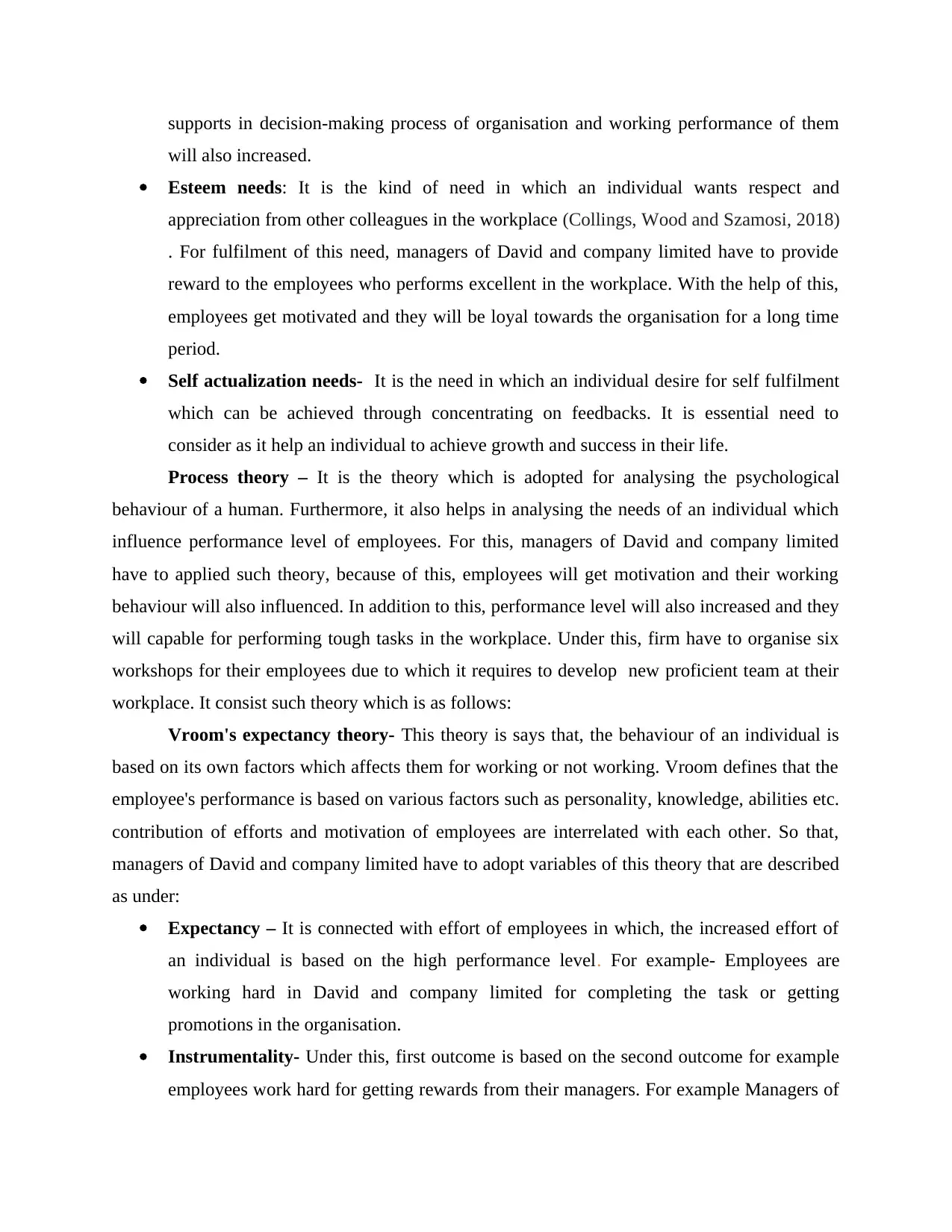
supports in decision-making process of organisation and working performance of them
will also increased.
Esteem needs: It is the kind of need in which an individual wants respect and
appreciation from other colleagues in the workplace (Collings, Wood and Szamosi, 2018)
. For fulfilment of this need, managers of David and company limited have to provide
reward to the employees who performs excellent in the workplace. With the help of this,
employees get motivated and they will be loyal towards the organisation for a long time
period.
Self actualization needs- It is the need in which an individual desire for self fulfilment
which can be achieved through concentrating on feedbacks. It is essential need to
consider as it help an individual to achieve growth and success in their life.
Process theory – It is the theory which is adopted for analysing the psychological
behaviour of a human. Furthermore, it also helps in analysing the needs of an individual which
influence performance level of employees. For this, managers of David and company limited
have to applied such theory, because of this, employees will get motivation and their working
behaviour will also influenced. In addition to this, performance level will also increased and they
will capable for performing tough tasks in the workplace. Under this, firm have to organise six
workshops for their employees due to which it requires to develop new proficient team at their
workplace. It consist such theory which is as follows:
Vroom's expectancy theory- This theory is says that, the behaviour of an individual is
based on its own factors which affects them for working or not working. Vroom defines that the
employee's performance is based on various factors such as personality, knowledge, abilities etc.
contribution of efforts and motivation of employees are interrelated with each other. So that,
managers of David and company limited have to adopt variables of this theory that are described
as under:
Expectancy – It is connected with effort of employees in which, the increased effort of
an individual is based on the high performance level. For example- Employees are
working hard in David and company limited for completing the task or getting
promotions in the organisation.
Instrumentality- Under this, first outcome is based on the second outcome for example
employees work hard for getting rewards from their managers. For example Managers of
will also increased.
Esteem needs: It is the kind of need in which an individual wants respect and
appreciation from other colleagues in the workplace (Collings, Wood and Szamosi, 2018)
. For fulfilment of this need, managers of David and company limited have to provide
reward to the employees who performs excellent in the workplace. With the help of this,
employees get motivated and they will be loyal towards the organisation for a long time
period.
Self actualization needs- It is the need in which an individual desire for self fulfilment
which can be achieved through concentrating on feedbacks. It is essential need to
consider as it help an individual to achieve growth and success in their life.
Process theory – It is the theory which is adopted for analysing the psychological
behaviour of a human. Furthermore, it also helps in analysing the needs of an individual which
influence performance level of employees. For this, managers of David and company limited
have to applied such theory, because of this, employees will get motivation and their working
behaviour will also influenced. In addition to this, performance level will also increased and they
will capable for performing tough tasks in the workplace. Under this, firm have to organise six
workshops for their employees due to which it requires to develop new proficient team at their
workplace. It consist such theory which is as follows:
Vroom's expectancy theory- This theory is says that, the behaviour of an individual is
based on its own factors which affects them for working or not working. Vroom defines that the
employee's performance is based on various factors such as personality, knowledge, abilities etc.
contribution of efforts and motivation of employees are interrelated with each other. So that,
managers of David and company limited have to adopt variables of this theory that are described
as under:
Expectancy – It is connected with effort of employees in which, the increased effort of
an individual is based on the high performance level. For example- Employees are
working hard in David and company limited for completing the task or getting
promotions in the organisation.
Instrumentality- Under this, first outcome is based on the second outcome for example
employees work hard for getting rewards from their managers. For example Managers of
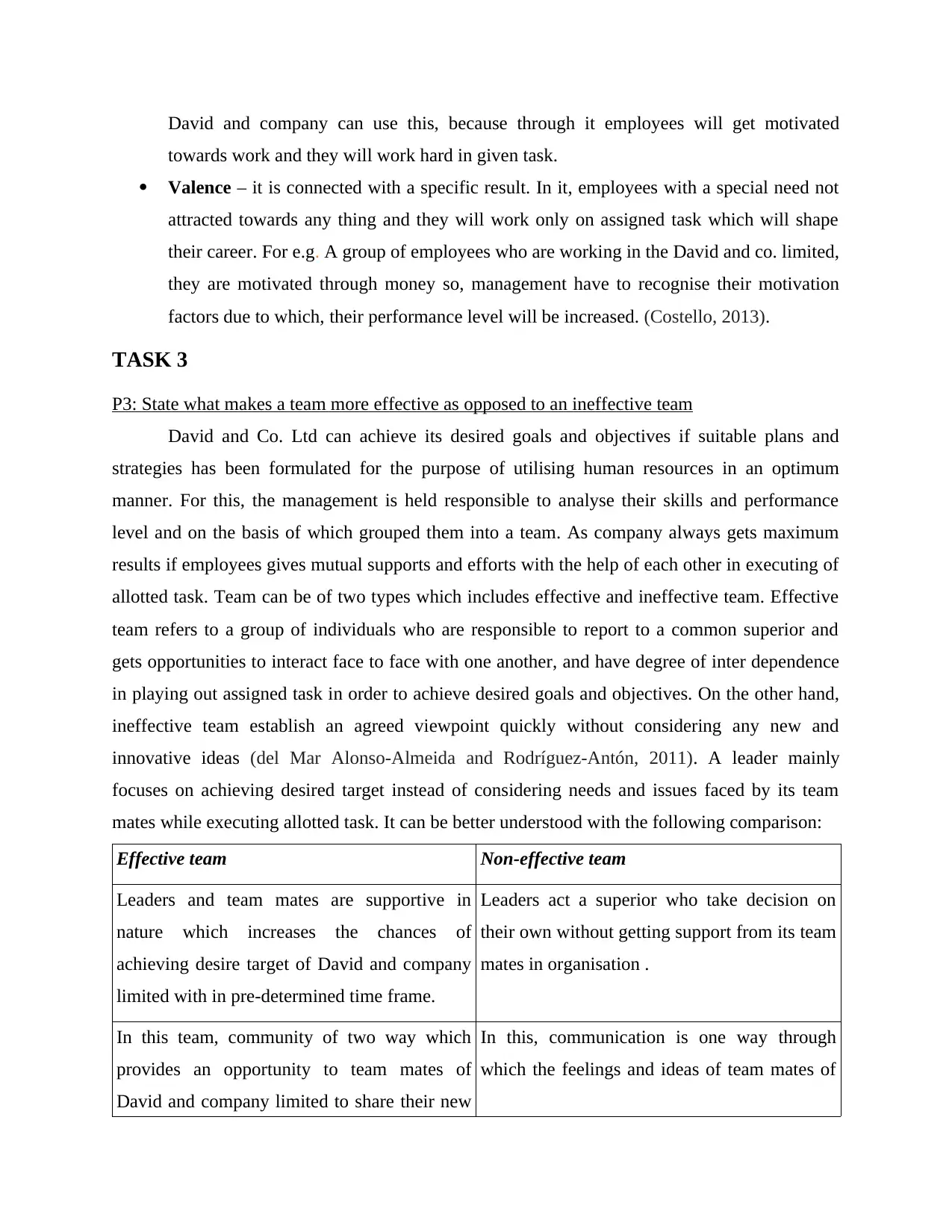
David and company can use this, because through it employees will get motivated
towards work and they will work hard in given task.
Valence – it is connected with a specific result. In it, employees with a special need not
attracted towards any thing and they will work only on assigned task which will shape
their career. For e.g. A group of employees who are working in the David and co. limited,
they are motivated through money so, management have to recognise their motivation
factors due to which, their performance level will be increased. (Costello, 2013).
TASK 3
P3: State what makes a team more effective as opposed to an ineffective team
David and Co. Ltd can achieve its desired goals and objectives if suitable plans and
strategies has been formulated for the purpose of utilising human resources in an optimum
manner. For this, the management is held responsible to analyse their skills and performance
level and on the basis of which grouped them into a team. As company always gets maximum
results if employees gives mutual supports and efforts with the help of each other in executing of
allotted task. Team can be of two types which includes effective and ineffective team. Effective
team refers to a group of individuals who are responsible to report to a common superior and
gets opportunities to interact face to face with one another, and have degree of inter dependence
in playing out assigned task in order to achieve desired goals and objectives. On the other hand,
ineffective team establish an agreed viewpoint quickly without considering any new and
innovative ideas (del Mar Alonso-Almeida and Rodríguez-Antón, 2011). A leader mainly
focuses on achieving desired target instead of considering needs and issues faced by its team
mates while executing allotted task. It can be better understood with the following comparison:
Effective team Non-effective team
Leaders and team mates are supportive in
nature which increases the chances of
achieving desire target of David and company
limited with in pre-determined time frame.
Leaders act a superior who take decision on
their own without getting support from its team
mates in organisation .
In this team, community of two way which
provides an opportunity to team mates of
David and company limited to share their new
In this, communication is one way through
which the feelings and ideas of team mates of
towards work and they will work hard in given task.
Valence – it is connected with a specific result. In it, employees with a special need not
attracted towards any thing and they will work only on assigned task which will shape
their career. For e.g. A group of employees who are working in the David and co. limited,
they are motivated through money so, management have to recognise their motivation
factors due to which, their performance level will be increased. (Costello, 2013).
TASK 3
P3: State what makes a team more effective as opposed to an ineffective team
David and Co. Ltd can achieve its desired goals and objectives if suitable plans and
strategies has been formulated for the purpose of utilising human resources in an optimum
manner. For this, the management is held responsible to analyse their skills and performance
level and on the basis of which grouped them into a team. As company always gets maximum
results if employees gives mutual supports and efforts with the help of each other in executing of
allotted task. Team can be of two types which includes effective and ineffective team. Effective
team refers to a group of individuals who are responsible to report to a common superior and
gets opportunities to interact face to face with one another, and have degree of inter dependence
in playing out assigned task in order to achieve desired goals and objectives. On the other hand,
ineffective team establish an agreed viewpoint quickly without considering any new and
innovative ideas (del Mar Alonso-Almeida and Rodríguez-Antón, 2011). A leader mainly
focuses on achieving desired target instead of considering needs and issues faced by its team
mates while executing allotted task. It can be better understood with the following comparison:
Effective team Non-effective team
Leaders and team mates are supportive in
nature which increases the chances of
achieving desire target of David and company
limited with in pre-determined time frame.
Leaders act a superior who take decision on
their own without getting support from its team
mates in organisation .
In this team, community of two way which
provides an opportunity to team mates of
David and company limited to share their new
In this, communication is one way through
which the feelings and ideas of team mates of
⊘ This is a preview!⊘
Do you want full access?
Subscribe today to unlock all pages.

Trusted by 1+ million students worldwide
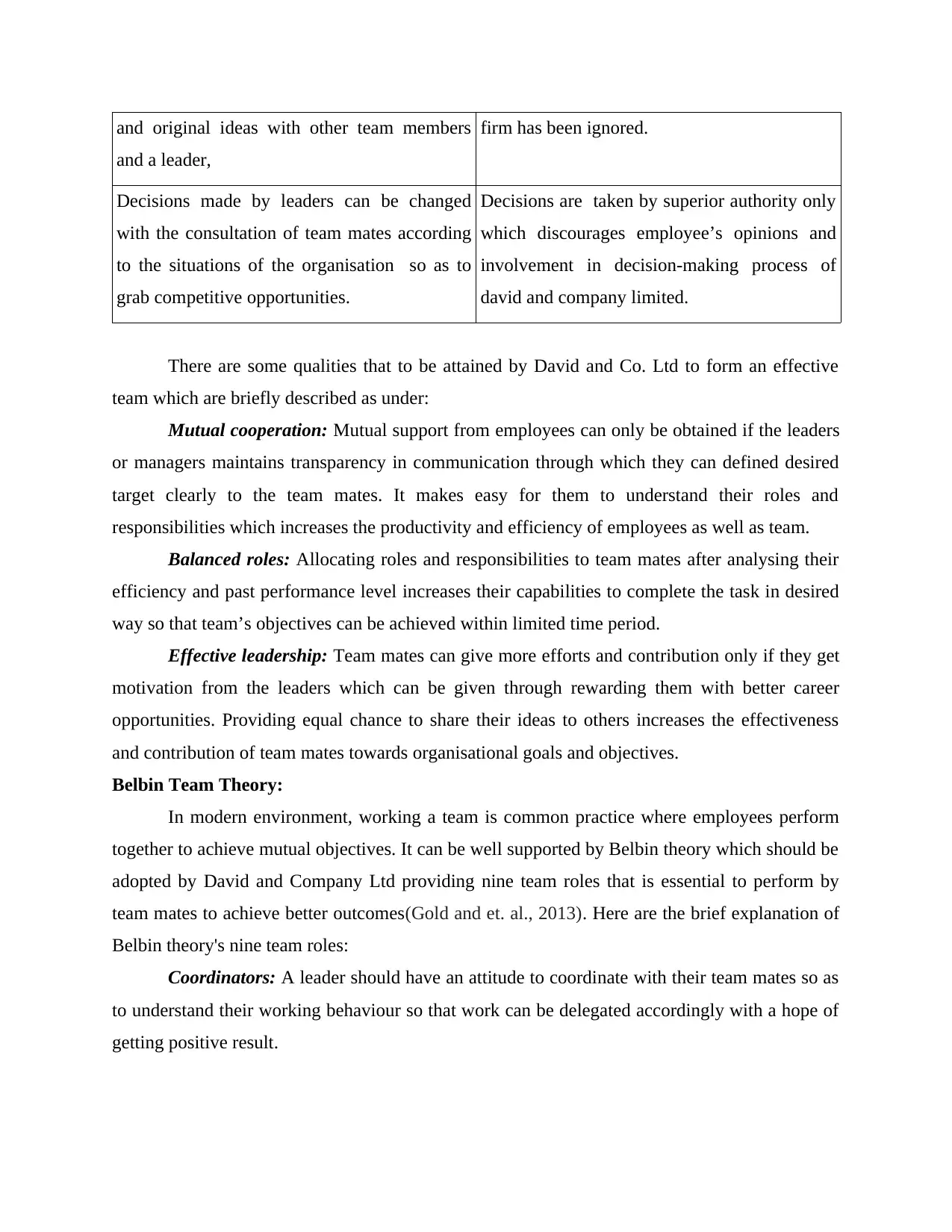
and original ideas with other team members
and a leader,
firm has been ignored.
Decisions made by leaders can be changed
with the consultation of team mates according
to the situations of the organisation so as to
grab competitive opportunities.
Decisions are taken by superior authority only
which discourages employee’s opinions and
involvement in decision-making process of
david and company limited.
There are some qualities that to be attained by David and Co. Ltd to form an effective
team which are briefly described as under:
Mutual cooperation: Mutual support from employees can only be obtained if the leaders
or managers maintains transparency in communication through which they can defined desired
target clearly to the team mates. It makes easy for them to understand their roles and
responsibilities which increases the productivity and efficiency of employees as well as team.
Balanced roles: Allocating roles and responsibilities to team mates after analysing their
efficiency and past performance level increases their capabilities to complete the task in desired
way so that team’s objectives can be achieved within limited time period.
Effective leadership: Team mates can give more efforts and contribution only if they get
motivation from the leaders which can be given through rewarding them with better career
opportunities. Providing equal chance to share their ideas to others increases the effectiveness
and contribution of team mates towards organisational goals and objectives.
Belbin Team Theory:
In modern environment, working a team is common practice where employees perform
together to achieve mutual objectives. It can be well supported by Belbin theory which should be
adopted by David and Company Ltd providing nine team roles that is essential to perform by
team mates to achieve better outcomes(Gold and et. al., 2013). Here are the brief explanation of
Belbin theory's nine team roles:
Coordinators: A leader should have an attitude to coordinate with their team mates so as
to understand their working behaviour so that work can be delegated accordingly with a hope of
getting positive result.
and a leader,
firm has been ignored.
Decisions made by leaders can be changed
with the consultation of team mates according
to the situations of the organisation so as to
grab competitive opportunities.
Decisions are taken by superior authority only
which discourages employee’s opinions and
involvement in decision-making process of
david and company limited.
There are some qualities that to be attained by David and Co. Ltd to form an effective
team which are briefly described as under:
Mutual cooperation: Mutual support from employees can only be obtained if the leaders
or managers maintains transparency in communication through which they can defined desired
target clearly to the team mates. It makes easy for them to understand their roles and
responsibilities which increases the productivity and efficiency of employees as well as team.
Balanced roles: Allocating roles and responsibilities to team mates after analysing their
efficiency and past performance level increases their capabilities to complete the task in desired
way so that team’s objectives can be achieved within limited time period.
Effective leadership: Team mates can give more efforts and contribution only if they get
motivation from the leaders which can be given through rewarding them with better career
opportunities. Providing equal chance to share their ideas to others increases the effectiveness
and contribution of team mates towards organisational goals and objectives.
Belbin Team Theory:
In modern environment, working a team is common practice where employees perform
together to achieve mutual objectives. It can be well supported by Belbin theory which should be
adopted by David and Company Ltd providing nine team roles that is essential to perform by
team mates to achieve better outcomes(Gold and et. al., 2013). Here are the brief explanation of
Belbin theory's nine team roles:
Coordinators: A leader should have an attitude to coordinate with their team mates so as
to understand their working behaviour so that work can be delegated accordingly with a hope of
getting positive result.
Paraphrase This Document
Need a fresh take? Get an instant paraphrase of this document with our AI Paraphraser
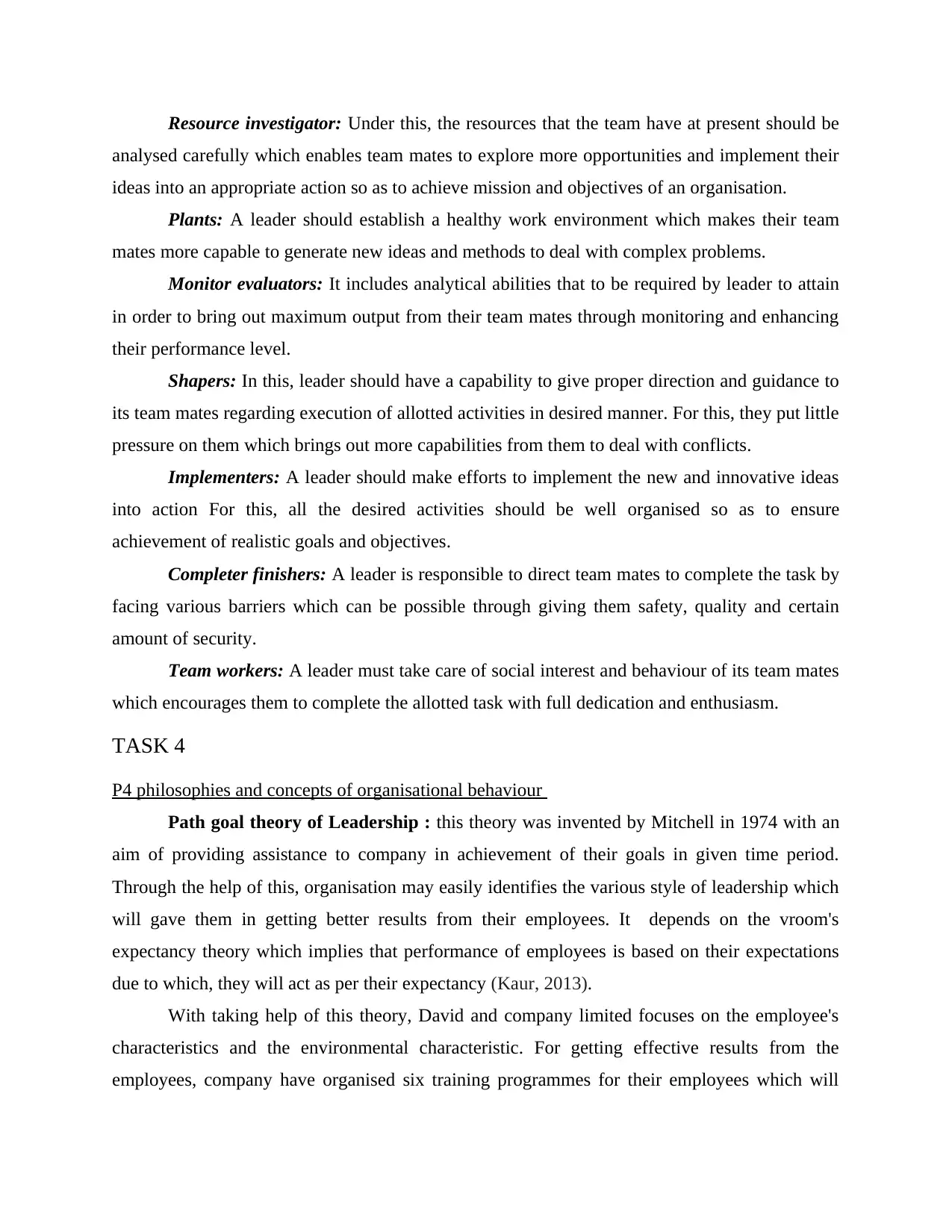
Resource investigator: Under this, the resources that the team have at present should be
analysed carefully which enables team mates to explore more opportunities and implement their
ideas into an appropriate action so as to achieve mission and objectives of an organisation.
Plants: A leader should establish a healthy work environment which makes their team
mates more capable to generate new ideas and methods to deal with complex problems.
Monitor evaluators: It includes analytical abilities that to be required by leader to attain
in order to bring out maximum output from their team mates through monitoring and enhancing
their performance level.
Shapers: In this, leader should have a capability to give proper direction and guidance to
its team mates regarding execution of allotted activities in desired manner. For this, they put little
pressure on them which brings out more capabilities from them to deal with conflicts.
Implementers: A leader should make efforts to implement the new and innovative ideas
into action For this, all the desired activities should be well organised so as to ensure
achievement of realistic goals and objectives.
Completer finishers: A leader is responsible to direct team mates to complete the task by
facing various barriers which can be possible through giving them safety, quality and certain
amount of security.
Team workers: A leader must take care of social interest and behaviour of its team mates
which encourages them to complete the allotted task with full dedication and enthusiasm.
TASK 4
P4 philosophies and concepts of organisational behaviour
Path goal theory of Leadership : this theory was invented by Mitchell in 1974 with an
aim of providing assistance to company in achievement of their goals in given time period.
Through the help of this, organisation may easily identifies the various style of leadership which
will gave them in getting better results from their employees. It depends on the vroom's
expectancy theory which implies that performance of employees is based on their expectations
due to which, they will act as per their expectancy (Kaur, 2013).
With taking help of this theory, David and company limited focuses on the employee's
characteristics and the environmental characteristic. For getting effective results from the
employees, company have organised six training programmes for their employees which will
analysed carefully which enables team mates to explore more opportunities and implement their
ideas into an appropriate action so as to achieve mission and objectives of an organisation.
Plants: A leader should establish a healthy work environment which makes their team
mates more capable to generate new ideas and methods to deal with complex problems.
Monitor evaluators: It includes analytical abilities that to be required by leader to attain
in order to bring out maximum output from their team mates through monitoring and enhancing
their performance level.
Shapers: In this, leader should have a capability to give proper direction and guidance to
its team mates regarding execution of allotted activities in desired manner. For this, they put little
pressure on them which brings out more capabilities from them to deal with conflicts.
Implementers: A leader should make efforts to implement the new and innovative ideas
into action For this, all the desired activities should be well organised so as to ensure
achievement of realistic goals and objectives.
Completer finishers: A leader is responsible to direct team mates to complete the task by
facing various barriers which can be possible through giving them safety, quality and certain
amount of security.
Team workers: A leader must take care of social interest and behaviour of its team mates
which encourages them to complete the allotted task with full dedication and enthusiasm.
TASK 4
P4 philosophies and concepts of organisational behaviour
Path goal theory of Leadership : this theory was invented by Mitchell in 1974 with an
aim of providing assistance to company in achievement of their goals in given time period.
Through the help of this, organisation may easily identifies the various style of leadership which
will gave them in getting better results from their employees. It depends on the vroom's
expectancy theory which implies that performance of employees is based on their expectations
due to which, they will act as per their expectancy (Kaur, 2013).
With taking help of this theory, David and company limited focuses on the employee's
characteristics and the environmental characteristic. For getting effective results from the
employees, company have organised six training programmes for their employees which will
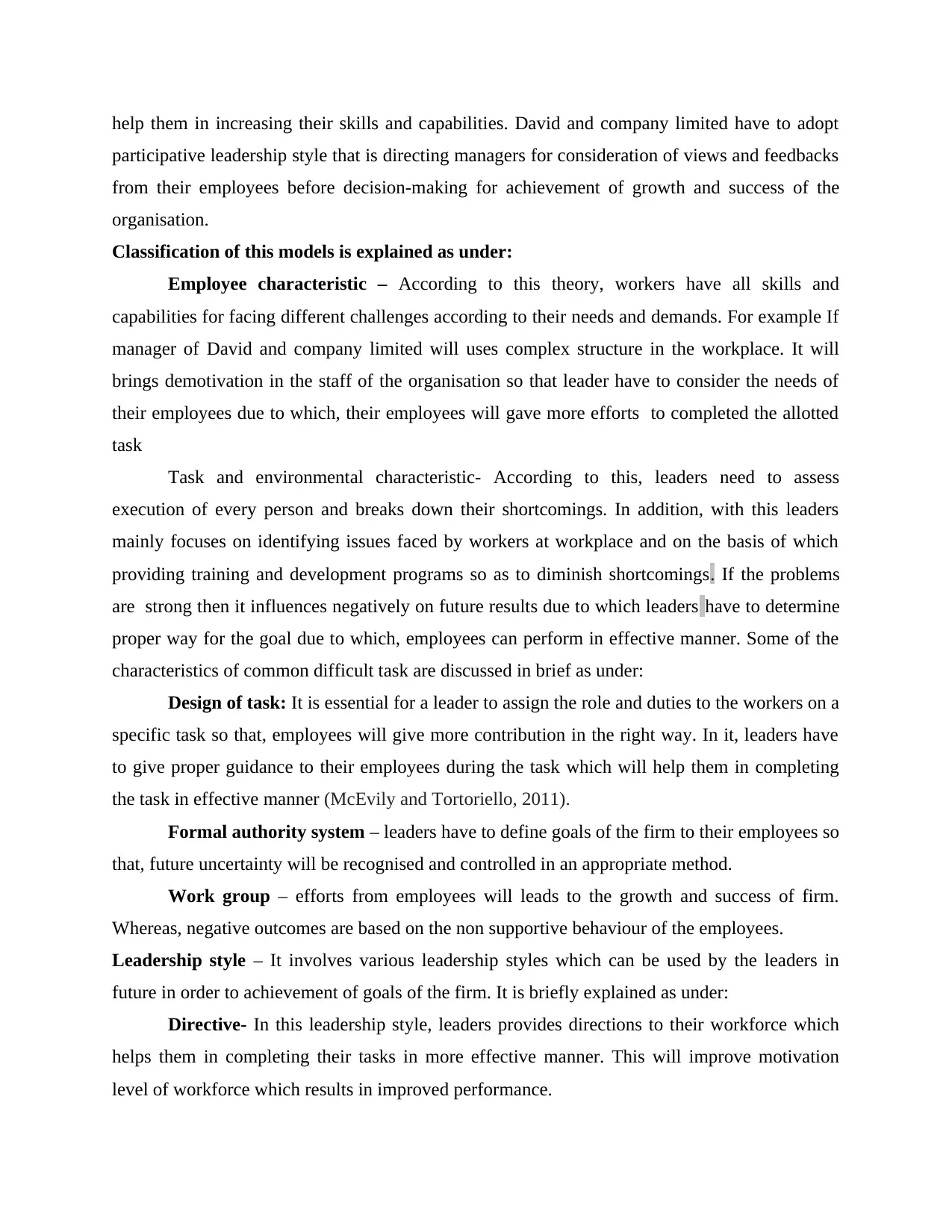
help them in increasing their skills and capabilities. David and company limited have to adopt
participative leadership style that is directing managers for consideration of views and feedbacks
from their employees before decision-making for achievement of growth and success of the
organisation.
Classification of this models is explained as under:
Employee characteristic – According to this theory, workers have all skills and
capabilities for facing different challenges according to their needs and demands. For example If
manager of David and company limited will uses complex structure in the workplace. It will
brings demotivation in the staff of the organisation so that leader have to consider the needs of
their employees due to which, their employees will gave more efforts to completed the allotted
task
Task and environmental characteristic- According to this, leaders need to assess
execution of every person and breaks down their shortcomings. In addition, with this leaders
mainly focuses on identifying issues faced by workers at workplace and on the basis of which
providing training and development programs so as to diminish shortcomings. If the problems
are strong then it influences negatively on future results due to which leaders have to determine
proper way for the goal due to which, employees can perform in effective manner. Some of the
characteristics of common difficult task are discussed in brief as under:
Design of task: It is essential for a leader to assign the role and duties to the workers on a
specific task so that, employees will give more contribution in the right way. In it, leaders have
to give proper guidance to their employees during the task which will help them in completing
the task in effective manner (McEvily and Tortoriello, 2011).
Formal authority system – leaders have to define goals of the firm to their employees so
that, future uncertainty will be recognised and controlled in an appropriate method.
Work group – efforts from employees will leads to the growth and success of firm.
Whereas, negative outcomes are based on the non supportive behaviour of the employees.
Leadership style – It involves various leadership styles which can be used by the leaders in
future in order to achievement of goals of the firm. It is briefly explained as under:
Directive- In this leadership style, leaders provides directions to their workforce which
helps them in completing their tasks in more effective manner. This will improve motivation
level of workforce which results in improved performance.
participative leadership style that is directing managers for consideration of views and feedbacks
from their employees before decision-making for achievement of growth and success of the
organisation.
Classification of this models is explained as under:
Employee characteristic – According to this theory, workers have all skills and
capabilities for facing different challenges according to their needs and demands. For example If
manager of David and company limited will uses complex structure in the workplace. It will
brings demotivation in the staff of the organisation so that leader have to consider the needs of
their employees due to which, their employees will gave more efforts to completed the allotted
task
Task and environmental characteristic- According to this, leaders need to assess
execution of every person and breaks down their shortcomings. In addition, with this leaders
mainly focuses on identifying issues faced by workers at workplace and on the basis of which
providing training and development programs so as to diminish shortcomings. If the problems
are strong then it influences negatively on future results due to which leaders have to determine
proper way for the goal due to which, employees can perform in effective manner. Some of the
characteristics of common difficult task are discussed in brief as under:
Design of task: It is essential for a leader to assign the role and duties to the workers on a
specific task so that, employees will give more contribution in the right way. In it, leaders have
to give proper guidance to their employees during the task which will help them in completing
the task in effective manner (McEvily and Tortoriello, 2011).
Formal authority system – leaders have to define goals of the firm to their employees so
that, future uncertainty will be recognised and controlled in an appropriate method.
Work group – efforts from employees will leads to the growth and success of firm.
Whereas, negative outcomes are based on the non supportive behaviour of the employees.
Leadership style – It involves various leadership styles which can be used by the leaders in
future in order to achievement of goals of the firm. It is briefly explained as under:
Directive- In this leadership style, leaders provides directions to their workforce which
helps them in completing their tasks in more effective manner. This will improve motivation
level of workforce which results in improved performance.
⊘ This is a preview!⊘
Do you want full access?
Subscribe today to unlock all pages.

Trusted by 1+ million students worldwide
1 out of 14
Related Documents
Your All-in-One AI-Powered Toolkit for Academic Success.
+13062052269
info@desklib.com
Available 24*7 on WhatsApp / Email
![[object Object]](/_next/static/media/star-bottom.7253800d.svg)
Unlock your academic potential
Copyright © 2020–2025 A2Z Services. All Rights Reserved. Developed and managed by ZUCOL.





